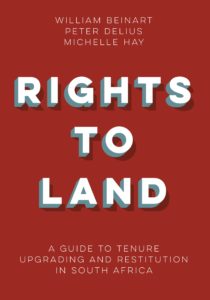
PUBLISHER: Fanele (an imprint of Jacana Media): Johannesburg.
REVIEWER: CHRIS DE WET
This book seeks to take stock of the South African government’s post 1994 land reform initiatives, by asking to what extent they have actually improved the rights to land of those previously deprived of land by apartheid. It does so through a focus on two of the three aspects of the overall land reform programme (i.e. land tenure reform and land restitution), considering principally whether people’s rights and security of tenure in relation to land have been increased, and suggesting measures the authors argue will enhance such a positive outcome.
The central issues advanced in the book relate to the dualistic land ownership and administrative system which originated in colonial and apartheid South Africa. The dualism relates to a communally based and non-registered land rights approach characteristic of land relationships in ‘former homelands and black areas’, as against a private property land rights system, with formal individual title, in ‘former white South Africa’. In their detailed examination of laws passed since 1994, land related court cases, as well as case studies relating to land access in relation to land tenure and land restitution, the authors argue that this dualism still characterises post 1994 land reform initiatives.
The authors claim that, central to the implementation of post 1994 land reform, is the notion of a community, through which individuals and families will receive their access to land (which do not amount to individual or family title level rights) and through which community, their land related activities are to be effectively organised. It is in terms of this logic that Communal Property Associations were brought into being from 1996 onwards, and it is through CPAs that land access is effectively obtained in a land reform context. CPAs control members’ rights to land, and as the case studies of land restitution in the book illustrate, such structures lend themselves to political manipulation by those who control them, including local chiefs.
Collective organisation of agricultural production and marketing is not necessarily efficient, and land restitution schemes do not have a great record in this regard.
The argument is therefore advanced that, without denying the practical complexities and trade-offs, involved, it is more desirable to seek to move towards the greater securities and dignities of a single, title-oriented land tenure system in South Africa as a whole, than to remain with the historical legacies and inefficiencies of a dualistic approach to land tenure.
Land restitution needs to be efficiently finalised (given that it was initially conceptualised as a limited exercise), rather than having new and expanding time lines and claims. There should be no reason why rural restitution claims cannot be resolved through cash, rather than land allocations. Available land can then rather be used more agriculturally effectively via land redistribution. Land reform should concentrate not only on righting the land access injustices of the past, but importantly, also on working effectively with the land so as to help right the economic problems resulting from such historical injustice.
What lessons might the arguments advanced in this book hold for cases of restitution type situations that we are familiar with in our own area, such as Farmerfield, Salem Commonage, Fish River Sun Hotel, and Double Drift Reserve? How do community dynamics and local power relations operate in these situations? With people moving back on to the former Mission of Farmerfield?
Several former communal tenure villages in the Keiskammahoek area that had to move into centralised settlements as part of the government’s betterment programme in the 1960s and 1970s, were incorporated into the land restitution programme in the 2000s; the affected families were actually restituted in cash, for the land which they had lost at the time. Our local Eastern Cape cases relate to the arguments raised in the book that, for land reform to be effective, it needs to be concerned not only with restoring and strengthening people’s land rights, but also with enabling agricultural productivity post settlement.
This raises the land reform issue which has become very prominent since this book went to press, i.e. expropriation with or without compensation. Ask yourself whether the searching issues and suggestions raised in this very thorough overview of the areas of land tenure reform and land restitution cast any light for you on the expropriation with/out compensation issue, and whether it has any implications for how we should be thinking about land reform.
- Chris de Wet is an anthropologist who has worked on forced resettlement and land reform issues, both in the Eastern Cape and more widely.
http://www.grocotts.co.za/2018/03/28/land-claims-article


